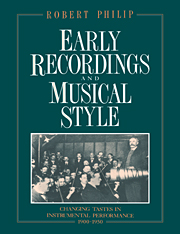9 - Implications for the future
Published online by Cambridge University Press: 22 September 2009
Summary
The most obvious trends in performing style over the first half of the twentieth century are easily summarised. Broadly speaking, early twentieth-century playing was characterised by the following habits: the sparing use of vibrato by string-players, its discreet use by singers, and the general avoidance of vibrato on woodwind instruments by most players except those of the French school; the frequent use of prominent, often slow, portamento by string-players and singers; the use of substantial tempo changes to signal changes of mood or tension, and the adoption of fast maximum tempos; varieties of tempo rubato which included not only detailed flexibility of tempo, but also accentuation by lengthening and shortening individual notes, and the dislocation of melody and accompaniment; and a tendency, in patterns of long and short notes, to shorten the short notes, and to overdot dotted rhythms. Instruments were also different from their modern equivalents in some ways – gut strings (used to a decreasing extent after World War I), wooden flutes (widely used except by the French school), French bassoons (not in Germany and Austria), and, though they have not been discussed in this book, the continued use of narrow-bore brass instruments.
- Type
- Chapter
- Information
- Early Recordings and Musical StyleChanging Tastes in Instrumental Performance, 1900–1950, pp. 229 - 240Publisher: Cambridge University PressPrint publication year: 1992



